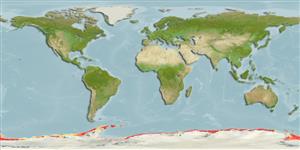Environment: milieu / climate zone / depth range / distribution range
Ecologia
marinhas bentopelágico; intervalo de profundidade 200 - 800 m (Ref. 5200). Polar; 60°S - 78°S, 180°W - 180°E (Ref. 5200)
Southern Ocean: Circum-Antarctic on Antarctic continental shelf. Northernmost records from vicinity of South Orkney Islands and Antarctic Peninsula.
Comprimento de primeira maturação / Tamanho / Peso / Idade
Maturity: Lm ?, range 23 - ? cm
Max length : 43.0 cm TL macho/indeterminado; (Ref. 5200); common length : 30.0 cm TL macho/indeterminado; (Ref. 2805)
Espinhos dorsais (total): 5 - 8; Raios dorsais (total): 38-42; Espinhos anais 0; Raios anais : 32 - 36. Supraorbital ridge not crenulated. Middle lateral line restricted to caudal peduncle; lower lateral line originating from in front of anal-fin origin to above sixth anal ray. Maxilla extending to below anterior third of eye. Opercular bones with 2 upper and 3 lower spines. Preopercular-mandibular canal not joined to temporal canal. Pelvic fins extending beyond anal-fin origin. In life, pale grey, whitish ventrally. Differentiated by the dorsoventrally oval shape; the prominent distally rounded rostrum, pseudo-rostrum and pseudo-antirostrum; the clearly defined excisura ostii and pseudo-excisura ostii; the acutely constricted collum; and the well developed colliculli.
Ontogeny: The excisura ostii and the pseudo-excisura ostii become deeper and the crista inferior becomes less distinct with an increase in the fish size.
Common in shallower waters of the continental shelf, especially on banks less than 250 m deep in areas where local upwelling increase food supply (Ref. 6390). Postlarvae and pelagic juveniles are also found in the upper 100 m (Ref. 5200). Food consists of fishes and krill. Spawn in winter (Ref. 6390). Larval pelagic phase is long (Ref. 28915). Prey to penguins and seals (Ref. 6390). Utilized as a food fish (Ref. 5200).
Iwami, T. and K.-H. Kock, 1990. Channichthyidae. p. 381-389. In O. Gon and P.C. Heemstra (eds.) Fishes of the Southern Ocean. J.L.B. Smith Institute of Ichthyology, Grahamstown, South Africa. 462 p. (Ref. 5200)
Status na Lista Vermelha da UICN (Ref. 130435)
Ameaça para os humanos
Harmless
Uso pelos humanos
Pescarias: pouco comercial
Mais informação
ReferênciasAquaculturaPerfil para aquaculturaEstirpesGenéticaElectrophoresesHereditariedadeDoençasProcessamentoNutrientsConversão de massa
ColaboradoresFotosStamps, Coins Misc.SonsCiguateraVelocidadeTipo de nataçãoÁrea branquialOtólitosCérebrosVisão
Ferramentas
Relatórios especiais
Baixar XML
Fontes da internet
Estimates based on models
Preferred temperature (Ref.
123201): -1.8 - 1.4, mean -0.8 °C (based on 825 cells).
Índice de diversidade filogenética (Ref.
82804): PD
50 = 1.0000 [Uniqueness, from 0.5 = low to 2.0 = high].
Bayesian length-weight: a=0.00095 (0.00056 - 0.00163), b=3.54 (3.39 - 3.69), in cm total length, based on LWR estimates for this species & (Sub)family-body (Ref.
93245).
Nível Trófico (Ref.
69278): 3.2 ±0.2 se; based on diet studies.
Resiliência (Ref.
120179): médio(a), tempo mínimo de duplicação da população 1,4 - 4,4 anos (Fec = 393-862).
Fishing Vulnerability (Ref.
59153): Low to moderate vulnerability (33 of 100).
Climate Vulnerability (Ref.
125649): High vulnerability (64 of 100).
Nutrients (Ref.
124155): Calcium = 24.1 [13.1, 52.5] mg/100g; Iron = 0.394 [0.164, 0.807] mg/100g; Protein = 16.6 [14.9, 18.4] %; Omega3 = 0.238 [0.110, 0.509] g/100g; Selenium = 23 [8, 56] μg/100g; VitaminA = 20.2 [4.2, 101.6] μg/100g; Zinc = 0.466 [0.301, 0.712] mg/100g (wet weight);
